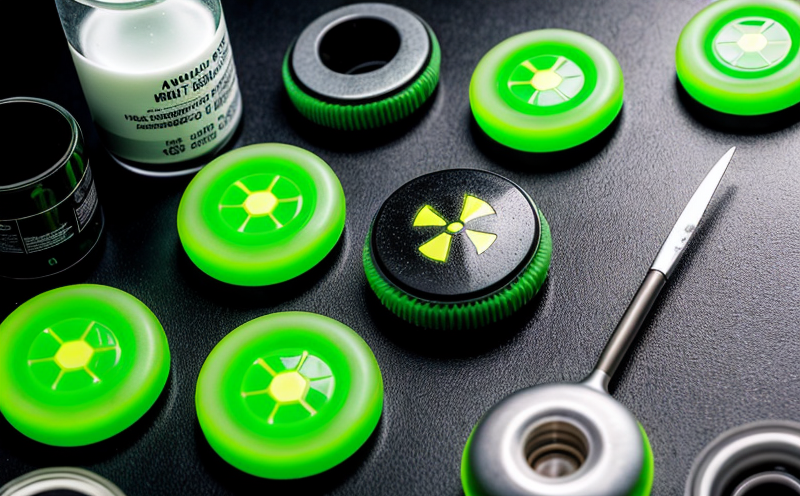EN 20137 Gamma Spectrometry Profiling in Meat Products
The European standard EN 20137 is a method used to perform gamma spectrometry profiling on meat products. This technique provides detailed information about the levels of naturally occurring and man-made radionuclides present within these products. The primary objective of this test is to ensure compliance with international standards for food safety, particularly in relation to radioactivity. Meat products are subject to various contaminants due to environmental factors or industrial processes; hence, gamma spectrometry ensures that the meat meets stringent quality and safety requirements.
Gamma spectrometry profiling involves measuring the intensity of gamma radiation emitted by radioactive isotopes present within a sample. This process is non-destructive and provides precise quantitative data on the levels of different radionuclides. The method adheres to ISO standards, ensuring accuracy and reliability in the results. By using this technique, laboratories can identify any potential contamination issues early enough to take corrective actions.
The EN 20137 standard is particularly important for meat products as it addresses the issue of radioactive contamination which could arise from various sources such as nuclear fallout or industrial waste disposal near agricultural areas. The test focuses on detecting radionuclides like uranium (U-238), thorium (Th-232), and potassium-40, among others. These elements are naturally occurring in the environment but can pose health risks if their concentrations exceed safe limits.
Another critical aspect of gamma spectrometry profiling is its ability to detect man-made radionuclides like cesium-137 (Cs-137) and strontium-90 (Sr-90), which are often produced during nuclear testing or accidents. These isotopes can accumulate in the environment through various pathways, including air deposition, water runoff, and soil erosion. Once they enter the food chain, particularly at higher trophic levels like meat products, their presence becomes significant.
The gamma spectrometer used in this profiling process measures the energy spectrum of gamma rays emitted from the sample. This provides detailed information about the composition and quantity of radioactive isotopes present. The instrument is capable of distinguishing between different types of radiation based on their unique energies, allowing for accurate identification and quantification of each radionuclide.
A typical procedure involves preparing a representative sample of the meat product according to specified guidelines outlined in EN 20137. This may include slicing the meat into small pieces, ensuring homogeneity across all parts of the specimen. After preparation, the samples are placed inside a lead shielding container designed to block external interference and concentrate the emitted gamma rays onto a detector. The detector then records the energies and intensities of the detected photons, generating an energy spectrum.
The resulting spectra contain peaks corresponding to different radionuclides present in the sample. Analysts use statistical methods to analyze these data points, comparing them against known standards for acceptable levels of radioactivity. This helps determine whether any contamination has occurred and assesses its severity.
Compliance with EN 20137 ensures that meat products meet European Union regulations regarding food safety concerning radioactive contaminants. This is crucial not only from a public health perspective but also in maintaining consumer confidence in the quality of imported goods. Laboratories performing this test must possess state-of-the-art equipment and trained personnel to ensure accurate results.
Moreover, gamma spectrometry profiling plays a vital role in ensuring compliance with international standards like ISO 17025 for laboratory accreditation. Accreditation ensures that laboratories adhere strictly to best practices in testing procedures, quality assurance measures, and data interpretation techniques. This adds credibility to the test results and enhances trust among stakeholders involved in the meat industry.
In conclusion, EN 20137 gamma spectrometry profiling is an essential tool for monitoring radioactivity levels in meat products. It provides critical insights into potential contamination sources while ensuring that processed meats comply with strict safety standards set by regulatory bodies worldwide. By leveraging this technology, quality managers and compliance officers can make informed decisions about product safety and ensure continuous improvement in production processes.
Applied Standards
The European standard EN 20137 for gamma spectrometry profiling in meat products is aligned with several international standards aimed at ensuring food safety. Primarily, it adheres to the principles outlined by ISO (International Organization for Standardization) and IAEA (International Atomic Energy Agency).
- ISO 14698:2013 - This standard provides requirements for laboratories conducting microbiological testing, which can complement gamma spectrometry when assessing overall food safety.
- IAEA Safety Standards Series No. GS-5 - These guidelines offer recommendations on radiation protection practices in nuclear medicine departments and facilities handling radioactive materials.
- EN 16432 - This standard specifies procedures for the determination of radionuclides in foodstuffs, further supporting the accuracy and reliability of gamma spectrometry results.
The application of these standards ensures that laboratories conducting EN 20137 comply with best practices in analytical chemistry and radiation safety. Compliance with such rigorous standards enhances confidence in the test outcomes and supports regulatory compliance across borders.
Eurolab Advantages
At Eurolab, we offer a comprehensive suite of services tailored to meet the unique needs of our clients operating within the food & feed testing sector. Our expertise in EN 20137 gamma spectrometry profiling sets us apart as leaders in this field.
- Accreditation and Expertise: Eurolab is fully accredited by the European Co-operation for Accreditation (EA) to perform tests according to EN 20137. Our team comprises highly skilled professionals with extensive experience in radiation detection and measurement techniques.
- State-of-the-Art Equipment: We utilize advanced gamma spectrometers that provide accurate and reliable results, ensuring precision even under challenging conditions.
- Comprehensive Reporting: Beyond just providing numerical data, Eurolab offers detailed reports including interpretative analysis to help clients understand the implications of their test results.
- Client-Specific Solutions: Our flexible approach allows us to customize our services based on individual client requirements, whether they involve routine testing or complex research projects.
Our commitment to excellence and innovation ensures that Eurolab remains at the forefront of food & feed testing. By choosing us, clients gain access to industry-leading expertise and technology, backed by robust quality assurance processes.





